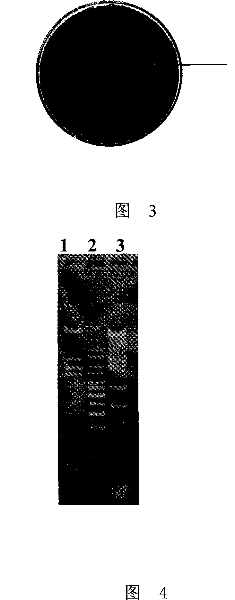Endoglucanase as well as encoding gene and use thereof
An endoglucanase and coding gene technology, which is applied in application, genetic engineering, plant genetic improvement, etc., can solve problems such as high cost, inability to truly realize industrialization, and high price
- Summary
- Abstract
- Description
- Claims
- Application Information
AI Technical Summary
Problems solved by technology
Method used
Image
Examples
Embodiment 1
[0035] Embodiment 1, the acquisition of endoglucanase Umcel5B and its coding gene
[0036] 1. Construction of metagenomic library of buffalo rumen uncultured microorganisms
[0037] 1. Extraction of uncultured microbial metagenomics from buffalo rumen
[0038] Get 50g buffalo rumen contents (the source of the sample is the rumen of the buffalo just slaughtered by Nanning Meat Co., Ltd., and the collected sample is immediately preserved with liquid nitrogen), suspended in 200ml of 0.18M potassium phosphate buffer (pH6.5), Gently oscillate evenly, let stand for 10 minutes, let the cellulose particles in the rumen content automatically precipitate, discard the supernatant, and then add 200ml of 0.18M potassium phosphate buffer (pH6.5) to wash the sediment twice, and the last time Metagenomic DNA of microorganisms adsorbed to cellulose pellets was extracted by direct extraction from pellets. Add 100ml of extraction buffer (100mM sodium phosphate pH8.0; 100mM Tirs-HCl pH8.0; 100m...
Embodiment 2
[0057] Embodiment 2, expression of umcel5B in Escherichia coli
[0058] 1. Construction of a recombinant vector (pET-umcel5B) capable of expressing umcel5B
[0059] After the gene with coding signal peptide is expressed in vivo, the expression product is likely to be secreted outside the cell. In order to avoid the secretion of the expression product outside the cell, only the 326th to 1881th base of the 5' end of the artificially synthesized sequence 1 (that is, the DNA sequence in the umcel5B gene except for the coding signal peptide functional domain and the stop codon), 1556bp , the predicted molecular weight of the encoded protein is 58.39332KDa, and the isoelectric point pI is 4.98.
[0060] Artificially synthesize the entire sequence of the umcel5B gene except the signal peptide and the stop codon (that is, the 326-1881 nucleotide sequence at the 5' end of sequence 1), and the two ends of the synthetic umcel5B gene have NcoI and XhoI restriction sites, After synthesis...
PUM
| Property | Measurement | Unit |
|---|---|---|
| molecular weight | aaaaa | aaaaa |
| molecular weight | aaaaa | aaaaa |
Abstract
Description
Claims
Application Information
 Login to View More
Login to View More - R&D
- Intellectual Property
- Life Sciences
- Materials
- Tech Scout
- Unparalleled Data Quality
- Higher Quality Content
- 60% Fewer Hallucinations
Browse by: Latest US Patents, China's latest patents, Technical Efficacy Thesaurus, Application Domain, Technology Topic, Popular Technical Reports.
© 2025 PatSnap. All rights reserved.Legal|Privacy policy|Modern Slavery Act Transparency Statement|Sitemap|About US| Contact US: help@patsnap.com



